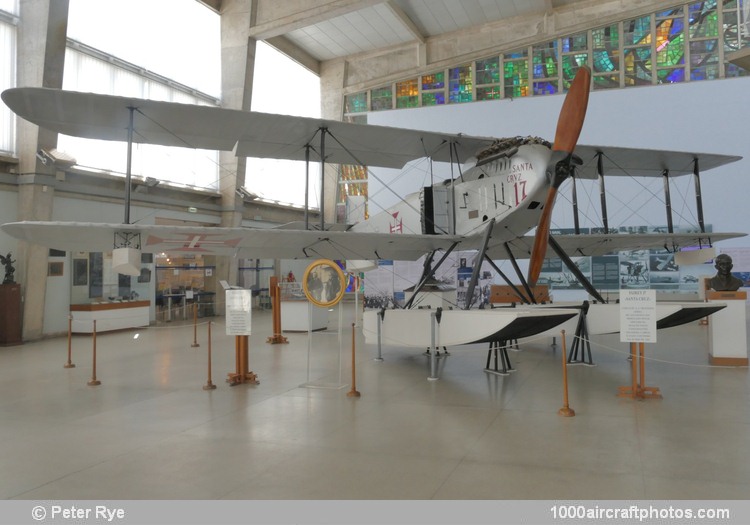08/31/2019. Remarks by Johan Visschedijk: "In 1921 the Portuguese Government ordered three IIIDs (c/n F.400 to F.402) powered by 365 hp Rolls-Royce Eagle VIII twelve-cylinder liquid-cooled V-engines. Later a replacement (c/n F.411) and seven more (c/n F.543 to F.549) were ordered, these had 450 hp Napier Lion II twelve-cylinder liquid-cooled broad-arrow engines. The first IIID for Portugal (c/n F.400) was a special long-range version - known initially as the 'Load Carrier' and later as the 'Transatlantic Load Carrier' intended for an attempt to fly across the South Atlantic to Brazil (originally colonized by Portugal) on a goodwill and flag-showing mission.
It was flown for the first time by test pilot Vincent Nicholl from Hamble on January 4, 1922, and, with the help of a 62 ft 18.90 m) span, provided by the addition of two extra bays, and of the camber gear, was soon flying at a weight of 7,250 lb (3,289 kg). This was probably then a record weight for any single-engined aircraft and represented a power loading of 20 lb/hp (9 kg/hp) with the 365 hp Eagle fitted.
The disposable load was given by the makers as 3,100 lb (1,406 kg) and this fact led, before the actual purpose of the aircraft had been announced, to suppositions about the number of passengers which might be carried after allowances had been made for furnishings, heating, silencing, luggage and fuel. However, in its initial form, c/n F.400 had two float-like objects under the wing below the inner interplane struts and these were rightly assumed to be fuel tanks. They were deleted before delivery by ship to Portugal, and their fuel was carried in the main floats.
The aircraft was assembled by a Portuguese Naval Aviation team under the supervision of Ernest Oscar Tips, the later well-known aircraft designer. The crew for the flight consisted of two experienced naval officers, Commander Sacadura Cabral (pilot) and Captain Gago Coutinho (navigator). The Portuguese Admiralty had put aside the equivalent of £5,000 for the transatlantic flight - an appropriation which apparently included the cost of the aircraft, but not that of the vessels used to support the flight. These were the cruiser 'Republica' (based initially on the Cape Verde Islands), the sloop '5 de Outubro', and the gunboat 'Bengo' (on Las Palmas).
Because of the need to make the crossing as soon as possible to take advantage of favorable wind conditions, only three trial flights were made and no detailed consumption or speed tests were completed. The aircraft took off from Lisbon at 07.00 hr GMT on March 30, 1922, for the flight to Las Palmas on Gran Canaria, Canary Islands, which was reached after an uneventful flight of 8 hr 37 min - though flying wires were broken when alighting in a rough sea. On April 2 the flight was continued to Gando (also on Gran Canaria) where there were better conditions for a loaded take off for the flight to St. Vincent, Cape Verde Islands, which was made on April 5 in 10 hr 43 min. There the aircraft was delayed for twelve days by gales, an unserviceable main compass and leaking floats.
By then it was realized that, at the known consumption, the fuel capacity would be insufficient to reach Fernando Noronha, some 200 mls (320 km) from the Brazilian coast. Hence the decision was made to put down for refueling beside the Rocks of St. Peter and St. Paul, where the cruiser would be stationed. On April 17 the IIID was ferried from St. Vincent to Porto Praia at the island Santiago, for the take off on the longest stage which was flown on April 18. There were anxious moments because of the fuel situation, and a return to Cape Verde Islands was considered, but the wind was favorable and the aircraft reached the tiny St. Paul's Rocks after 11 hr 21 min in the air and with only the barest margin of fuel (reported as 0.8 gal, 3 l) remaining. Unfortunately the sea was rough, the port float sheared off and the sinking aircraft could not be salvaged.
With success so near, the Portuguese authorities were not willing to accept defeat and shipped a standard IIID floatplane (probably c/n F.401) to Fernando Noronha, where it arrived on May 6. To complete the flight correctly this was flown initially back to St. Paul's Rocks, but the engine cut while on the return flight and when about 170 mls (274 km) from Fernando Noronha and well off the shipping lanes. An alert had gone out to shipping, however, and at about midnight, when the aircraft was then partially submerged, a ship's lights were picked up, the signals from a flare pistol were seen by the ship's crew and all was tolerably well. When the supporting cruiser arrived in the early morning, however, only the engine of the IIID could be salvaged.
A subscription list was opened in Portugal for a replacement and another IIID (c/n F.402), which is preserved in the Naval Museum, Lisbon - with extra tanks, was shipped out on the cruiser Carvalho Araujo, arriving at Fernando Noronha on June 2. Starting on June 5 and ending on June 17, 1922, the flight was completed in five stages through Brasil: Recife – Salvador de Bahia – Porto Seguro – Vitória - Rio de Janeiro. A total distance of 5,025 mls (8,386 km) had thus been flown by three aircraft in a total flying time of 62 hr 26 min, or at an average speed of over 83 mph (134 kmh)."
